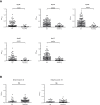Allergic Reactions to Serine Protease-Like Proteins of Staphylococcus aureus
- PMID: 33833764
- PMCID: PMC8021911
- DOI: 10.3389/fimmu.2021.651060
Allergic Reactions to Serine Protease-Like Proteins of Staphylococcus aureus
Abstract
In cystic fibrosis (CF) infectious and allergic airway inflammation cause pulmonary exacerbations that destroy the lungs. Staphylococcus aureus is a common long-term colonizer and cause of recurrent airway infections in CF. The pathogen is also associated with respiratory allergy; especially the staphylococcal serine protease-like proteins (Spls) can induce type 2 immune responses in humans and mice. We measured the serum IgE levels specific to 7 proteases of S. aureus by ELISA, targeting 5 Spls (76 CF patients and 46 controls) and the staphopains A and B (16 CF patients and 46 controls). Then we compared cytokine release and phenotype of T cells that had been stimulated with Spls between 5 CF patients and 5 controls. CF patients had strongly increased serum IgE binding to all Spls but not to the staphopains. Compared to healthy controls, their Spl-stimulated T cells released more type 2 cytokines (IL-4, IL-5, IL-13) and more IL-6 with no difference in the secretion of type 1- or type 3 cytokines (IFNγ, IL-17A, IL-17F). IL-10 production was low in CF T cells. The phenotype of the Spl-exposed T cells shifted towards a Th2 or Th17 profile in CF but to a Th1 profile in controls. Sensitization to S. aureus Spls is common in CF. This discovery could explain episodes of allergic inflammation of hitherto unknown causation in CF and extend the diagnostic and therapeutic portfolio.
Keywords: IgE; Staphylococcus aureus; Th2 cells; allergy; cystic fibrosis; type 2 immune response.
Copyright © 2021 Nordengrün, Abdurrahman, Treffon, Wächter, Kahl and Bröker.
Conflict of interest statement
The authors declare that the research was conducted in the absence of any commercial or financial relationships that could be construed as a potential conflict of interest.
Figures



Similar articles
-
Staphylococcal serine protease-like proteins are pacemakers of allergic airway reactions to Staphylococcus aureus.J Allergy Clin Immunol. 2017 Feb;139(2):492-500.e8. doi: 10.1016/j.jaci.2016.03.045. Epub 2016 May 10. J Allergy Clin Immunol. 2017. PMID: 27315768
-
Staphylococcus aureus Serine protease-like protein A (SplA) induces IL-8 by keratinocytes and synergizes with IL-17A.Cytokine. 2024 Aug;180:156634. doi: 10.1016/j.cyto.2024.156634. Epub 2024 May 28. Cytokine. 2024. PMID: 38810500
-
Mouse Strain-Dependent Difference Toward the Staphylococcus aureus Allergen Serine Protease-Like Protein D Reveals a Novel Regulator of IL-33.Front Immunol. 2020 Sep 25;11:582044. doi: 10.3389/fimmu.2020.582044. eCollection 2020. Front Immunol. 2020. PMID: 33072128 Free PMC article.
-
Protease/antiprotease network in allergy: The role of Staphylococcus aureus protease-like proteins.Allergy. 2019 Nov;74(11):2077-2086. doi: 10.1111/all.13783. Epub 2019 Apr 10. Allergy. 2019. PMID: 30888697 Review.
-
Staphylococcus aureus Manipulates Innate Immunity through Own and Host-Expressed Proteases.Front Cell Infect Microbiol. 2017 May 5;7:166. doi: 10.3389/fcimb.2017.00166. eCollection 2017. Front Cell Infect Microbiol. 2017. PMID: 28529927 Free PMC article. Review.
Cited by
-
A multi-omic analysis reveals the esophageal dysbiosis as the predominant trait of eosinophilic esophagitis.J Transl Med. 2023 Jan 25;21(1):46. doi: 10.1186/s12967-023-03898-x. J Transl Med. 2023. PMID: 36698146 Free PMC article.
-
[Screening of pathogenic molecular markers of Staphylococcus aureus in children based on whole genome sequencing technology].Zhongguo Dang Dai Er Ke Za Zhi. 2023 Nov 15;25(11):1161-1169. doi: 10.7499/j.issn.1008-8830.2304128. Zhongguo Dang Dai Er Ke Za Zhi. 2023. PMID: 37990462 Free PMC article. Chinese.
-
Microbiota and IL-33/31 Axis Linkage: Implications and Therapeutic Perspectives in Atopic Dermatitis and Psoriasis.Biomolecules. 2023 Jul 10;13(7):1100. doi: 10.3390/biom13071100. Biomolecules. 2023. PMID: 37509136 Free PMC article. Review.
-
Exploring the Role of Staphylococcus aureus in Inflammatory Diseases.Toxins (Basel). 2022 Jul 6;14(7):464. doi: 10.3390/toxins14070464. Toxins (Basel). 2022. PMID: 35878202 Free PMC article. Review.
-
Microbiome First Approaches to Rescue Public Health and Reduce Human Suffering.Biomedicines. 2021 Oct 30;9(11):1581. doi: 10.3390/biomedicines9111581. Biomedicines. 2021. PMID: 34829809 Free PMC article. Review.
References
-
- Cystic Fibrosis Foundation Patient Registry . Annual Data Report. Bethesda, Maryland: American Cystic Fibrosis Foundation; (2018).
-
- Hatziagorou E, Orenti A, Drevinek P, Kashirskaya N, Mei-Zahav M, de Boeck K. Changing epidemiology of the respiratory bacteriology of patients with cystic fibrosis-data from the European cystic fibrosis society patient registry. J Cyst Fibros (2020) 19:376–83. 10.1016/j.jcf.2019.08.006 - DOI - PubMed
-
- Lange J, Heidenreich K, Higelin K, Dyck K, Marx V, Reichel C, et al. . Staphylococcus aureus pathogenicity in cystic fibrosis patients-results from an observational prospective multicenter study concerning virulence genes, phylogeny, and gene plasticity. Toxins (Basel) (2020) 12:279. 10.3390/toxins12050279 - DOI - PMC - PubMed
Publication types
MeSH terms
Substances
LinkOut - more resources
Full Text Sources
Other Literature Sources
Medical

